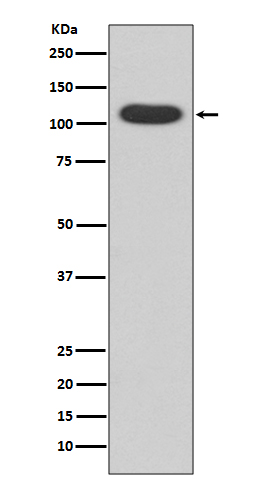
| WB | 1/500-1/1000 | Human,Mouse,Rat |
| IF | 咨询技术 | Human,Mouse,Rat |
| IHC | 咨询技术 | Human,Mouse,Rat |
| ICC | 1/50-1/200 | Human,Mouse,Rat |
| FCM | 咨询技术 | Human,Mouse,Rat |
| Elisa | 咨询技术 | Human,Mouse,Rat |
| Aliases | Ah receptor; AhR; Class E basic helix-loop-helix protein 76; bHLHe76; AHR |
| Entrez GeneID | 196 |
| WB Predicted band size | Calculated MW: 96 kDa; Observed MW: 105 kDa |
| Host/Isotype | Rabbit IgG |
| Antibody Type | Primary antibody |
| Storage | Store at 4°C short term. Aliquot and store at -20°C long term. Avoid freeze/thaw cycles. |
| Species Reactivity | Human |
| Immunogen | A synthesized peptide derived from human AhR |
| Formulation | Purified antibody in PBS with 0.05% sodium azide. |
+ +
以下是关于Aryl Hydrocarbon Receptor(AhR)抗体的3篇代表性文献的简要信息:
---
1. **文献名称**: "Characterization of a polyclonal antibody to the aryl hydrocarbon receptor (AhR) from multiple species"
**作者**: Denison MS, Whitlock JP Jr.
**摘要**: 该研究开发并验证了一种针对AhR的多克隆抗体,可识别小鼠、大鼠和人类等多种物种的AhR蛋白。通过免疫印迹(Western blot)和免疫沉淀实验,证实了抗体对AhR的特异性,并用于研究AhR在不同组织中的表达水平。
2. **文献名称**: "The aryl hydrocarbon receptor interacts with c-Maf to promote the differentiation of type 1 regulatory T cells induced by IL-27"
**作者**: Veldhoen M, Hirota K, Christensen J, et al.
**摘要**: 本研究利用AhR抗体(通过免疫荧光和流式细胞术)揭示了AhR与转录因子c-Maf的相互作用,阐明了AhR在IL-27诱导的调节性T细胞分化中的关键作用,为免疫调节机制提供了新见解。
3. **文献名称**: "Aryl hydrocarbon receptor (AhR) ligands as selective modulators of glutathione homeostasis via a novel AhR-dependent mechanism"
**作者**: Nguyen LP, Bradfield CA.
**摘要**: 通过AhR特异性抗体(如ChIP和Western blot),研究者发现AhR配体可通过激活AhR信号通路调控细胞内谷胱甘肽代谢,揭示了AhR在氧化应激反应中的新功能。
---
以上文献可通过PubMed或Google Scholar输入标题或作者名进一步检索原文。如需更多文献或具体应用场景(如特定实验方法),可提供补充信息。
The aryl hydrocarbon receptor (AhR) is a ligand-activated transcription factor belonging to the basic helix-loop-helix/Per-Arnt-Sim (bHLH-PAS) family. It plays a critical role in mediating cellular responses to environmental contaminants, such as dioxins and polycyclic aromatic hydrocarbons, by regulating the expression of detoxification enzymes (e.g., CYP1A1). Structurally, AhR contains a ligand-binding domain, a PAS domain for dimerization, and a transactivation domain. Upon ligand binding, AhR translocates to the nucleus, partners with ARNT (AhR nuclear translocator), and activates target genes involved in xenobiotic metabolism, immune regulation, and cellular homeostasis.
AhR antibodies are essential tools for studying its expression, localization, and activation in various tissues and disease models. They are widely used in techniques like Western blotting, immunofluorescence, and chromatin immunoprecipitation (ChIP). Researchers employ these antibodies to investigate AhR's role in pathologies, including cancer, autoimmune disorders, and inflammatory diseases. Specific antibodies may target distinct epitopes (e.g., N-terminal or C-terminal regions) or post-translational modifications, enabling precise analysis of AhR's functional states.
Recent studies also highlight AhR's interactions with endogenous ligands (e.g., tryptophan metabolites) and its crosstalk with signaling pathways like NF-κB and HIF-1α. AhR antibodies thus contribute to unraveling its dual role as a sensor of environmental toxins and a regulator of physiological processes.
×